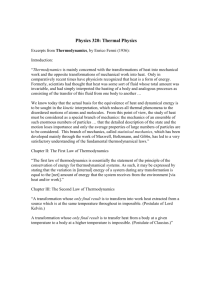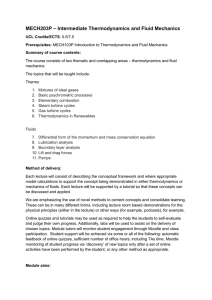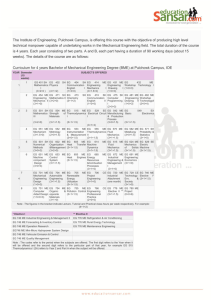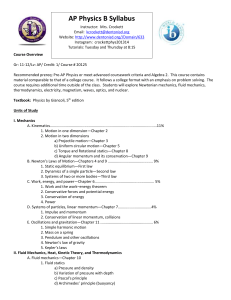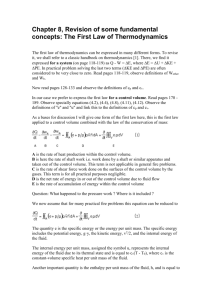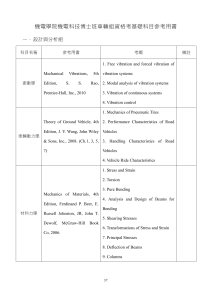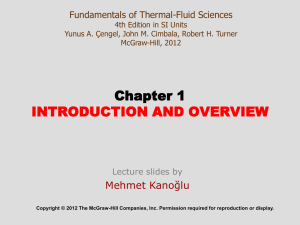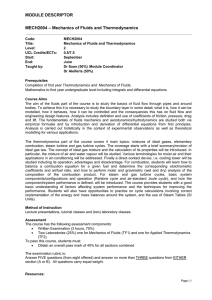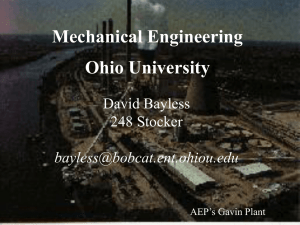MECH101 - University of Liverpool
advertisement
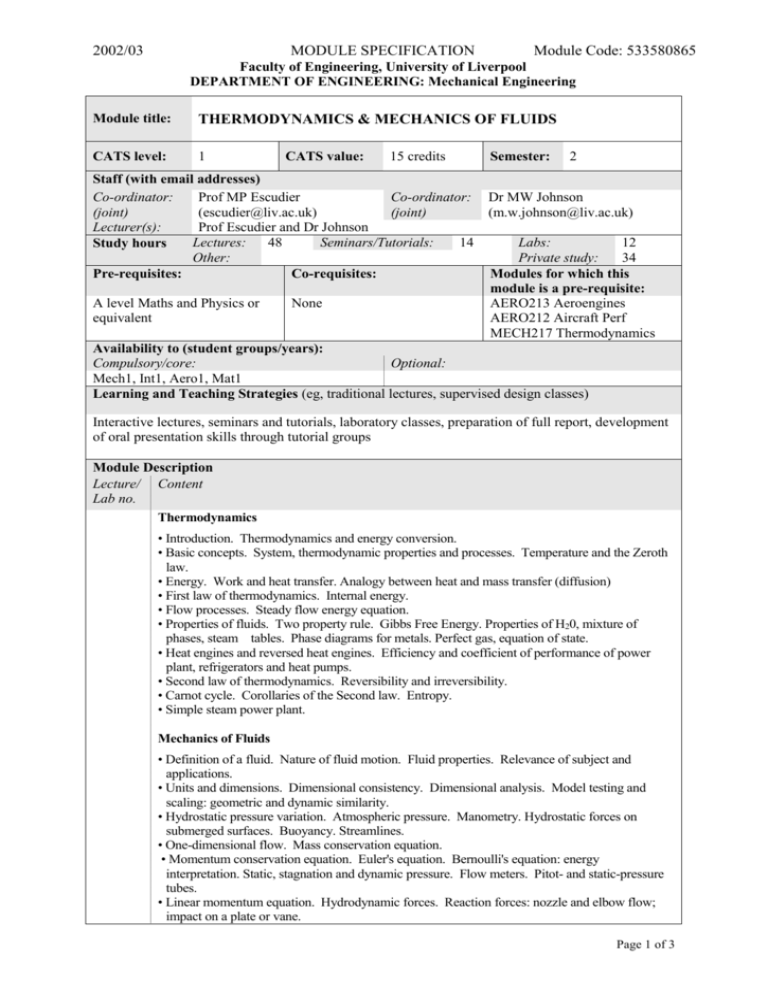
2002/03 MODULE SPECIFICATION Module Code: 533580865 Faculty of Engineering, University of Liverpool DEPARTMENT OF ENGINEERING: Mechanical Engineering Module title: THERMODYNAMICS & MECHANICS OF FLUIDS CATS level: 1 CATS value: 15 credits Staff (with email addresses) Co-ordinator: Prof MP Escudier Co-ordinator: (joint) (escudier@liv.ac.uk) (joint) Lecturer(s): Prof Escudier and Dr Johnson Lectures: 48 Seminars/Tutorials: 14 Study hours Other: Pre-requisites: Co-requisites: A level Maths and Physics or equivalent None Semester: 2 Dr MW Johnson (m.w.johnson@liv.ac.uk) Labs: 12 Private study: 34 Modules for which this module is a pre-requisite: AERO213 Aeroengines AERO212 Aircraft Perf MECH217 Thermodynamics Availability to (student groups/years): Compulsory/core: Optional: Mech1, Int1, Aero1, Mat1 Learning and Teaching Strategies (eg, traditional lectures, supervised design classes) Interactive lectures, seminars and tutorials, laboratory classes, preparation of full report, development of oral presentation skills through tutorial groups Module Description Lecture/ Content Lab no. Thermodynamics • Introduction. Thermodynamics and energy conversion. • Basic concepts. System, thermodynamic properties and processes. Temperature and the Zeroth law. • Energy. Work and heat transfer. Analogy between heat and mass transfer (diffusion) • First law of thermodynamics. Internal energy. • Flow processes. Steady flow energy equation. • Properties of fluids. Two property rule. Gibbs Free Energy. Properties of H20, mixture of phases, steam tables. Phase diagrams for metals. Perfect gas, equation of state. • Heat engines and reversed heat engines. Efficiency and coefficient of performance of power plant, refrigerators and heat pumps. • Second law of thermodynamics. Reversibility and irreversibility. • Carnot cycle. Corollaries of the Second law. Entropy. • Simple steam power plant. Mechanics of Fluids • Definition of a fluid. Nature of fluid motion. Fluid properties. Relevance of subject and applications. • Units and dimensions. Dimensional consistency. Dimensional analysis. Model testing and scaling: geometric and dynamic similarity. • Hydrostatic pressure variation. Atmospheric pressure. Manometry. Hydrostatic forces on submerged surfaces. Buoyancy. Streamlines. • One-dimensional flow. Mass conservation equation. • Momentum conservation equation. Euler's equation. Bernoulli's equation: energy interpretation. Static, stagnation and dynamic pressure. Flow meters. Pitot- and static-pressure tubes. • Linear momentum equation. Hydrodynamic forces. Reaction forces: nozzle and elbow flow; impact on a plate or vane. Page 1 of 3 2002/03 MODULE SPECIFICATION Module Code: 533580865 Laboratory Exercises TF1: TF2: TF3: TF4: TF5: TF6: Entropic Elasticity Heat Exchanger Wind Tunnel Aerofoil Characteristics (Aerospace Engineering) Flowmeter Calibration Jet Thrust and Momentum (Aerospace Engineering) Learning Outcomes Knowledge and Understanding: On successful completion of the module, students should be able to demonstrate knowledge and understanding of: Thermodynamics: • the equation of heat transfer as applied to problems of plane and circular geometries • the first law as applied to engineering systems • the steady flow energy equation as applied to a control volume • the determination of the performance of steam power plant using steam tables Mechanics of Fluids: • basic dimensional analysis to reduce a physical problem to non-dimensional form. • the principle of dynamic similarity to scale model data to full-scale • U-tube and inclined-tube manometers to measure applied pressure differences. • the horizontal and vertical components of the hydrostatic forces exerted on submerged surfaces, and the lines of action of those force components. • Bernoulli's equation as applied to internal and external flow problems • cavitation and the conditions under which it will occur in a liquid flow • the hydrodynamic forces which arise due to changes in the velocity and direction of a fluid stream.. Intellectual Abilities: On successful completion of the module, students should be able to demonstrate ability in applying knowledge of the above topics to basic problems and carrying out the associated analysis and calculations. Practical Skills On completion of the module, students should be able to show experience and enhancement of the following discipline-specific practical skills: in using appropriate modelling and analytical methods to solve problems in the above topics in carrying out Level 1 laboratory experiments in Thermodynamics and Fluid Mechanics following instruction, using test and measurement equipment and techniques, collecting and recording data, estimating accuracy, assessing errors, and using safe systems of work. General Transferable Skills On completion of the module, students should be able to show experience and enhancement of the following key skills: written communication skills through the preparation of a full technical report of a laboratory experiment oral presentation skills through making a short presentation on a technical subject team-working skills through participation in a group laboratory experiment and preparation of the group oral presentation. Page 2 of 3 2002/03 Assessment MODULE SPECIFICATION Weighting % Timing Duration/other 3 hours 3 hours per lab Oral Presentation Formal exam: Laboratory(s)*: 75 15 Continuous assessment(s)*: Other*: 5 May See lab programme Week 12 5 Week 8-12 Module Code: 533580865 Full report * The University Lateness Penalty Scheme applies to all coursework September Resit opportunity: Yes (formal exam only) Recommended reading: 1. Cengel Y A and Boles M A, Thermodynamics, 3rd Ed., McGraw-Hill, 1998. 2. Escudier, M P, The Essence of Engineering Fluid Mechanics, Prentice Hall, 1998. 3. White, F M, Fluid Mechanics 4th Edition, McGraw-Hill, 1999. 4. Wegner, P.P., What makes Airplanes Fly?, Springer-Verlag, 1991. 5. Rogers, J.F.C., and Mayhew, Y.R., Thermodynamic and Transport Properties of Fluids, Blackwell. External Examiner responsible for module: Mechanical Engineering (Thermofluids) Version date: 30 July 2002 Page 3 of 3
